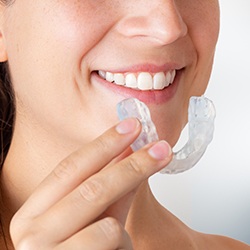TMJ Treatment – Jupiter, FL
Find Relief from Persistent Jaw Pain

Do you struggle with persistent jaw pain, difficulty chewing, or a popping sensation in your jaw? It is possible that you are suffering from TMJ disorder, also known as TMJ dysfunction or simply TMD. Fortunately, there are various treatments that can help you find long-lasting relief from your discomfort. Read on below to learn more about this condition and how our talented dentists can help you cope with it. Afterward, get in touch with us to request your consultation for TMJ treatment in Jupiter.
Why Choose Jupiter Implant and Cosmetic Dentistry for TMJ Treatment?
- Multiple Treatment Types Available
- BOTOX® Injections for Long-Lasting Pain Relief
- Friendly & Highly Skilled Team
What Is TMJ Disorder?

The temporomandibular joint (TMJ) connects your mandible (lower jaw) to the rest of your skull. It is a complex joint, and it is one of the most heavily used in the body. When it suffers damage, or the tissues around it are overworked, it can begin to ache and cause a range of other symptoms, which collectively contribute to TMJ disorder (TMD).
TMD can have a number of causes, including injury, dental misalignment, a stressful lifestyle, arthritis, and more.
Symptoms of TMJ Disorder

TMD is a complex condition that can cause dozens of symptoms. Here are some of the most common:
- Persistent pain and tenderness in the jaw
- The sensation of lockjaw
- Clicking or popping in the jaw joint
- Ear pain or ringing in the ears
- Neck pain
- Back aches
- Headaches and migraines
- Difficulty chewing, particularly when eating tough foods
- Limited movement of the mouth
- Noticeable changes in bite
Types of TMJ Treatment

There is no “one size fits all” TMJ treatment. When you come in for your consultation, we will strive to determine the cause of your TMD before we recommend your next steps. To that end, we may take some X-Rays, learn about your lifestyle and habits, carefully examine your teeth, and more. Based on what we learn, we may recommend one or more of the following forms of TMJ therapy:
Occlusal Splint

An occlusal splint is a small, custom appliance that prevents teeth grinding at night, which can contribute to problems with the TMJ. It also slightly shifts the jaw’s position in order to help it and the surrounding muscles relax.
Equilibration/Occlusal Adjustment

Many patients suffer from TMD because their upper and lower teeth do not work harmoniously together. In some cases, this issue requires orthodontic treatment to correct. In other cases, though, we can simply make slight alterations to the chewing surfaces of teeth or restorations in order to make minor adjustments to your bite.
Treatment with a TENS Machine

TENS is an acronym that stands for “transcutaneous electrical nerve stimulation.” That may sound complicated, but it basically means that electrical currents are used to relax your facial muscles and encourage the release of pain-killing endorphins. Essentially, TENS treatment is like a “self-massage.”
BOTOX® Injections

BOTOX® is often regarded as a purely cosmetic treatment, but it actually has a number of medical applications. As your dentist in Jupiter, we may recommend it as a way to address your TMD symptoms. When it is precisely injected into the muscles near the TMJ, it can prevent unnecessary movements and help them to relax.
After a series of BOTOX® injections, you can expect to enjoy several months of relief from TMJ pain. Periodic retreatment can allow you to experience long-lasting freedom from your symptoms.
TMJ Treatment FAQs
Is BOTOX for TMJ Safe?
BOTOX is short for botulinum toxin. This is produced by the bacterium Clostridium botulinum. Many people hesitate to have this toxin injected into their faces. However, when administered in the right dosage by a professional, BOTOX is typically considered to be a safe treatment option. Just like any treatment, BOTOX comes with some minor risks and side effects. They can include redness, bruising, soreness, mild nausea, and headaches. The risk of any serious side effects with BOTOX is very low, so many TMJ sufferers often find that this treatment is well worth it.
How Long Does It Take for a TMJ Splint to Work?
Occlusal splints for TMD are usually only worn to bed. Many patients find that their symptoms begin to diminish very quickly. However, they aren’t going to go away all at once. It takes time for the joint and surrounding areas to adjust. In most cases, it takes between 3 to 6 months for an occlusal splint to fully resolve TMD discomfort. Of course, everyone is different, so some people may experience recovery times that are shorter or longer.
Can TMD Be Treated Without Surgery?
Yes! The National Institutes of Health recommends using more conservative methods for treating TMJ dysfunction. When it comes to this condition, less is often more. Surgery involves making permanent changes to the jaw and nearby anatomy, so it is only suggested as a last resort. Most of the time, TMD can be treated with less invasive methods. In addition to at-home methods, like stress relief, patients see positive results with occlusal splints, equilibration/occlusal adjustment, treatment with a TENS machine, and BOTOX injections.
How Long Does Occlusal Equilibration Take for TMD?
Equilibration/occlusal adjustments can vary in how quickly they provide relief depending on the specific changes being made. However, once the teeth are better aligned, most patients experience relief soon after. This treatment usually takes a small number of appointments (1-3) for your dentist to complete the necessary adjustments to the teeth or restorations that are unevenly distributing your bite force.
